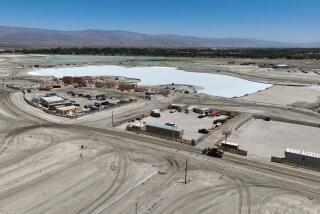New Cal State Campus Unveils Project to Fund Its Own Growth
- Share via
To the tapping of hammers, California State University officials Tuesday unveiled the first phase of a sprawling housing development expected to fuel expansion of Ventura County’s only four-year public university over the next 25 years.
The University Glen project, being built by Cal State Channel Islands at the base of the Santa Monica Mountains, will feature a mix of apartments, townhouses and single-family homes, all available at a discount to the university’s faculty and staff.
The first phase will consist of 207 units and serve as the cornerstone of a mini-city expected to mushroom over the next five years on the eastern edge of the Camarillo campus.
The development “will be absolutely essential as we move to build out the university in coming years,” Cal State Channel Islands President Richard Rush said after using an oversized pair of scissors to cut a red ribbon stretched across the entryway to the housing project.
Behind him, along what will become Anacapa Island Drive, stood dozens of wood-framed structures expected to be completed by the time the university opens in late August.
Four more phases will follow over the next five years, eventually providing 900 housing units as part of a self-contained community designed to sustain the college campus.
“It’s important to have affordable housing available so that this university can recruit the very best faculty and staff from around the world,” Rush said. “This gives them an affordable option in a very tight housing market.”
As part of the first phase, the college plans to offer 36 single-family homes--ranging from 1,689 square feet to 2,282 square feet--for $229,000 to $307,000. The price of a typical Ventura County home stands at $317,000.
In addition, the university will offer 71 townhouses, ranging from 1,300 square feet to 1,800 square feet, for sale or rent. Several financing packages--including low-interest loans and 100% financing--will be offered to help faculty and staff buy into the project. Already, more than a dozen faculty and staff members are in line to buy, and several other incoming faculty members have expressed interest.
“The interest level is good and it’s going to get better once people see the finished product,” said George Dutra, the university’s vice president for development.
The houses are part of a larger development planned for the campus. In June 2000, the CSU Channel Islands Site Authority approved a master plan to guide creation of a range of income-generating ventures designed to help the campus expand over the next quarter century.
At the heart of those efforts is the community of 900 houses, which will be crisscrossed with bike and pedestrian paths and will feature a child-care center, an elementary school and a town square complete with restaurants, bookstores and other businesses.
Taken together, those projects are designed to generate the millions of dollars needed to pay for new academic buildings and programs for as many as 15,000 students eventually expected to attend the university, which is under development at the former Camarillo State Hospital site.
Former Cal State University system trustee Jim Considine, who has been on the Channel Islands Site Authority board since the beginning, said the development deals were crucial to the university’s future.
Because of limited state funding, it became clear early that for the university to expand, it would have to find ways to generate money, Considine said.
University officials say it’s the first time ever that a developing Cal State campus, and perhaps a new campus anywhere, has been forced to fund its own growth by building money-making facilities. Considine was on hand Tuesday to see the fruits of that effort.
“It’s gratifying to take a look at it now,” he said. “There’s plenty more to do, but just to see it come this far is really fantastic.”
More to Read
Sign up for Essential California
The most important California stories and recommendations in your inbox every morning.
You may occasionally receive promotional content from the Los Angeles Times.













